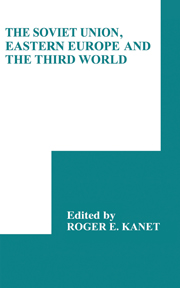Book contents
- Frontmatter
- Contents
- List of figures
- List of tables
- List of contributors
- Foreword by R.C. Elwood
- Preface by Roger E. Kanet
- PART 1 THE THIRD WORLD IN SOVIET FOREIGN POLICY
- 1 The Soviet Union and the Third World from Khrushchev to Gorbachev: the place of the Third World in evolving Soviet global strategy
- 2 Revolutionary change in the Third World: recent Soviet reassessments
- 3 Anti-Soviet insurgencies: growing trend or passing phase?
- 4 The Soviet Union and the New World Information Order
- 5 Soviet propaganda and the process of national liberation
- PART 2 CMEA ECONOMIC INVOLVEMENT IN THE THIRD WORLD
- PART 3 THE SOVIET UNION IN THE MIDDLE EAST AND SOUTH ASIA
- Index
- Publications from the Third World Congress for Soviet and East European Studies, Washington, 1985
1 - The Soviet Union and the Third World from Khrushchev to Gorbachev: the place of the Third World in evolving Soviet global strategy
from PART 1 - THE THIRD WORLD IN SOVIET FOREIGN POLICY
Published online by Cambridge University Press: 06 July 2010
- Frontmatter
- Contents
- List of figures
- List of tables
- List of contributors
- Foreword by R.C. Elwood
- Preface by Roger E. Kanet
- PART 1 THE THIRD WORLD IN SOVIET FOREIGN POLICY
- 1 The Soviet Union and the Third World from Khrushchev to Gorbachev: the place of the Third World in evolving Soviet global strategy
- 2 Revolutionary change in the Third World: recent Soviet reassessments
- 3 Anti-Soviet insurgencies: growing trend or passing phase?
- 4 The Soviet Union and the New World Information Order
- 5 Soviet propaganda and the process of national liberation
- PART 2 CMEA ECONOMIC INVOLVEMENT IN THE THIRD WORLD
- PART 3 THE SOVIET UNION IN THE MIDDLE EAST AND SOUTH ASIA
- Index
- Publications from the Third World Congress for Soviet and East European Studies, Washington, 1985
Summary
Since the end of the Second World War the conflict between the United States and the Soviet Union has been the single most important factor influencing the nature of the international political system. Within a relatively short period of time after the conclusion of hostilities in Europe and Asia the two countries were engaged in a struggle for influence that focused, initially at least, on Europe. Within only a few years the Soviets managed to create a zone of satellite states in Europe which they dominated; moreover, in Asia, communist parties allied to the Soviet Union came to power in China, North Korea and North Vietnam.
Despite the significant increase in Soviet influence in the regions bordering Soviet territory and the growth of Soviet military power during the decade after the Second World War, when Stalin died in 1953 the Soviets were still in a position of substantial inferiority in comparison with the United States. The USSR was still a regional power whose major international competitor, the United States, commanded far superior resources and dominated the international system politically, militarily, and economically. Postwar Soviet expansion had played a crucial role in stimulating the creation of an American-centered system of alliances in Europe and Asia, all of which were oriented toward preventing the further extension of Soviet power and influence. As a result of the creation of this alliance system US military forces were stationed around virtually the entire periphery of the communist world, from Germany in the west, through the Middle East, and as far east as Korea and Japan.
- Type
- Chapter
- Information
- The Soviet Union, Eastern Europe and the Third World , pp. 3 - 22Publisher: Cambridge University PressPrint publication year: 1988



